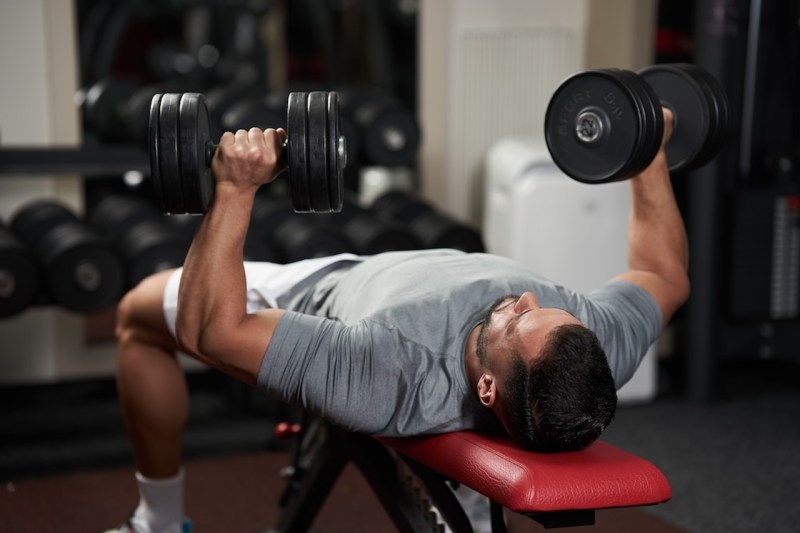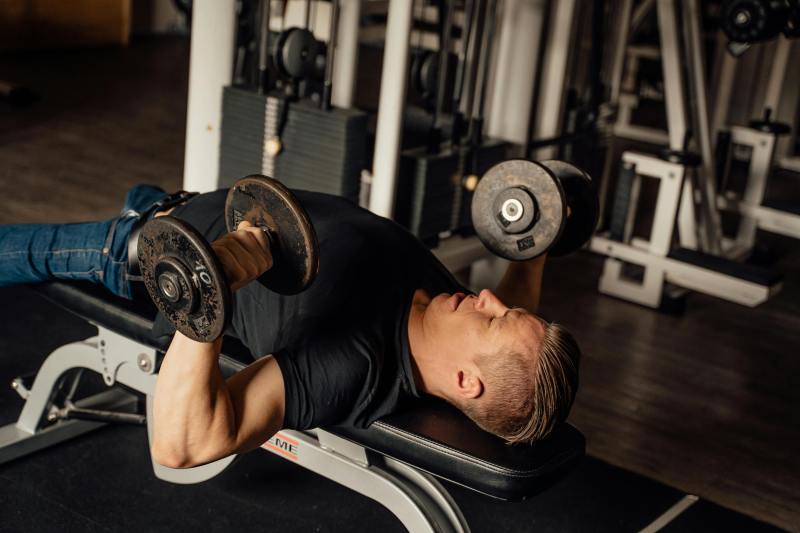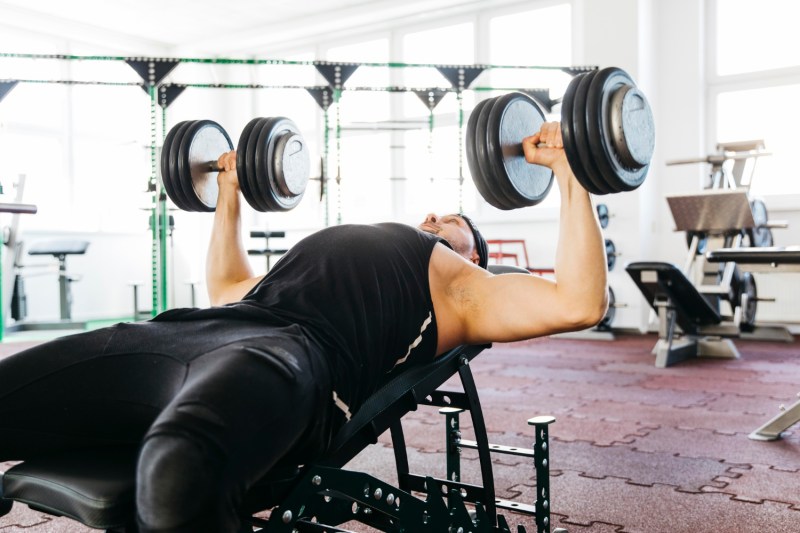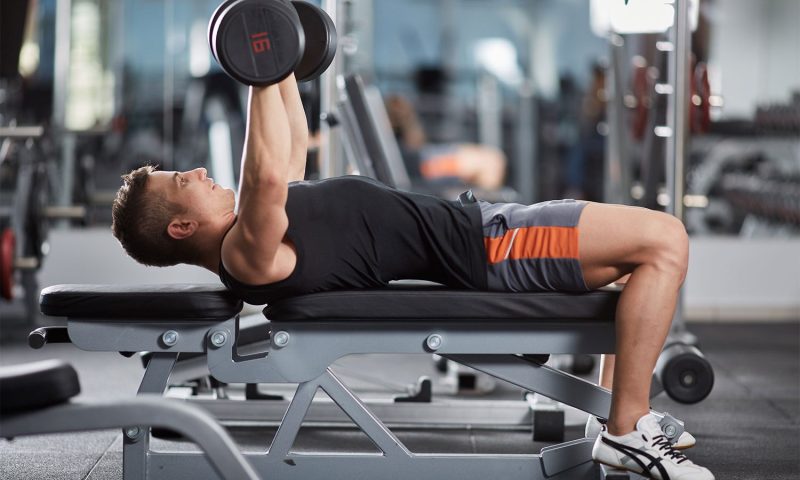Bench press is a classic exercise that is great for building the chest, triceps, and shoulders. As a personal trainer, I include it in nearly every client’s program, as well as my own. While I encourage you to bench press on a weekly basis, is one form better than the other? Should you stick to the classic barbell bench press or utilize other variations as well?
If you are interested in switching up your push day workout, keep reading to learn how to dumbbell bench press and get the best chest pump!
How to dumbbell bench press with perfect form

Instructions:
- Lie back on a flat bench holding a dumbbell in each hand. Rest the dumbbells on your thighs with your palms facing each other.
- Use your legs to help lift the dumbbells as you lie back, bringing them to chest level. Rotate your wrists so palms face forward.
- Keep your feet flat on the floor for stability, with your knees bent at about 90 degrees.
- Hold the dumbbells just outside your chest, elbows bent at about 90 degrees and tucked slightly (~45° angle) from your torso.
- Press your upper back into the bench, and push the dumbbells upward until your arms are fully extended but not locked out. Keep the movement controlled.
- Slowly lower the dumbbells back to the starting position, maintaining control and tension in your chest muscles.
- Exhale as you press up, inhale as you lower down.
Recommended sets and reps: 3 to 4 sets of 8 to 12 reps
What are the benefits of the dumbbell bench press?

When it comes to the general bench press movement, ASCM shares that it is “a compound, multiple joint upper body pushing exercise intended to increase strength and development in muscles within the chest, anterior (front) shoulder girdle, and posterior elbow joint.” Now, let’s dive into the benefits of the dumbbell bench press exercise specifically.
Improves muscle balance and stability
Using dumbbells requires each arm to work independently, helping correct muscle imbalances. This also engages stabilizer muscles more than a barbell, improving overall shoulder and chest stability.
Increases range of motion
Dumbbells allow a greater range of motion compared to barbells, letting you lower the weights deeper. This can lead to better muscle stretch and activation, promoting more effective muscle growth.
Reduces shoulder strain
Because you can adjust the angle of your wrists and elbows freely, dumbbell presses are often easier on the shoulders. This flexibility helps prevent common injuries associated with the fixed barbell path.
Enhances core engagement
Balancing two separate weights forces your core muscles to work harder to stabilize your body throughout the movement, improving overall core strength and stability.
How does this exercise compare to other bench press forms?

The dumbbell bench press offers unique advantages compared to other bench press forms. Unlike the barbell bench press, dumbbells allow each arm to move independently, which helps correct muscle imbalances and engages more stabilizer muscles. However, barbells typically let you lift heavier weights, which can be better for building maximum strength.
Compared to the incline bench press, which targets the upper chest and shoulders more, the flat dumbbell press focuses on the overall chest but allows a greater range of motion and joint freedom. The decline bench press shifts emphasis to the lower chest but is less common and may feel awkward for some lifters.
Dumbbell presses also reduce shoulder strain compared to fixed barbell movements, making them a safer option for those with joint issues. Overall, dumbbell bench presses provide more versatility and muscle engagement but usually require lighter weights than barbell variations.
Common mistakes to avoid

The dumbbell bench press is effective only when performed with proper form. Here are some common mistakes to avoid:
- Many lifters flare their elbows out too wide, which puts unnecessary stress on the shoulders.
- Using weights that are too heavy often leads to poor form, reducing exercise effectiveness and increasing the risk of injury.
- Failing to lower the dumbbells through a full range of motion limits muscle activation and growth potential.
- Arching the back excessively can strain the spine and take tension away from the chest muscles.
- Holding your breath during the lift can cause dizziness or increased blood pressure, so it’s important to exhale while pressing up and inhale while lowering the weights.
Frequently asked questions

Are dumbbell bench presses effective?
Yes, dumbbell bench presses are highly effective for building chest, shoulder, and tricep strength. They allow a greater range of motion and help correct muscle imbalances compared to barbells. Plus, they engage stabilizing muscles, improving overall upper-body coordination and muscle balance.
Is 70 lbs dumbbell chest press good?
Pressing 70 lb dumbbells is a strong achievement, especially for most recreational lifters. It indicates good upper-body strength and muscle development. However, what’s “good” depends on your experience, body weight, and goals.
Should my elbows be tucked during the dumbbell press?
Tucking your elbows slightly during a dumbbell press helps protect your shoulders and engage your chest muscles more effectively. Avoid flaring them out too wide, which can strain your joints. Aim for a 45-degree angle between your elbows and torso to maintain good form and reduce injury risk.




